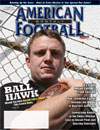Article CategoriesAFM Magazine
|
Conversion Routes in the Empty Offense - The Pivot and Spacing Conceptby: Mike KucharSenior Writer, American Football Monthly © More from this issue Running the empty offense has many advantages; the ability to stretch the field both horizontally and vertically, getting advantageous matchups on the perimeter and opening up run seams in the defense are just a few of them. Yet, many coaches are hesitant when it comes to installing the empty-look variation in their playbooks. Some even feel as if it needs to be an integral part of the offense in order to be run correctly. The fact of the matter is, it doesn’t. Where there is shotgun, there is empty; the adjustment is simply making a substitution for the single back. Most empty teams will even use their 10 personnel (one back, no tight end) structure and line the back up as a slot either way or motion him out on cadence. Whichever way one chooses, there is no better way to make a defense declare their rotation, coverage or front than....The full article can only be seen by subscribers.
|
|
|||||||
| HOME |
MAGAZINE |
SUBSCRIBE | ONLINE COLUMNISTS | COACHING VIDEOS |
Copyright 2026, AmericanFootballMonthly.com
All Rights Reserved





